Випуск 15. Скарб монет ХІ—ХІІІ ст. із Хотина
У 1889 році на території м. Хотин (тоді повітовий центр Бессарабської губернії) під час обробітку орендованої землі міщанин Архип Озарчук знайшов великий скарб срібних монет. За посередництва Російської імператорської академії наук і бессарабського віце-губернатора скарб передали до Ермітажу, де помилково назвали «Аккерманським». Хранитель Мюнцкабінету імперського музею відразу оцінив рідкісну знахідку як перший відомий йому скарб брактеатів. Від ХІХ ст. звичною практикою для Ермітажу був продаж музейних предметів, зокрема й вилучених з регіонів знахідок, за кордон. Тож екземпляри монет кращої збереженості з Хотинського скарбу росіяни продали німцям — в зібрання Берлінського мюнцкабінету та Нижньосаксонського крайового музею в Ганновері.
Загалом до складу скарбу входило від 1000 до 1600 монет. Понад 900 цілих і фрагментованих екземплярів і зараз знаходяться у зібранні Ермітажу.
Попри офіційні звернення до керівництва Ермітажу, росіяни систематично відмовляли українським науковцям бодай ознайомитися з цією колекцією середньовічних монет із Хотина.
З-поміж монет ідентифіковано 888 брактеатів, два денарії та один напівбрактеат. Брактеати — срібні монети, карбовані на тонкому кружку металу лише з одного боку (верхнім штемпелем на м’якій поверхні), через що зображення на аверсі виходило опуклим, а на реверсі — увігнутим. Вони мали діаметр до 40—45 мм і вагу близько 1 г. Мистецько виконані брактеати з Хотинського скарбу карбовані імператорами Священної Римської імперії, а також низкою світських і духовних вельмож на монетних дворах Тюрингії, Саксонії, Гарцу, Магдебурга, Гессена, Каринтії та Богемії. Найдавнішою монетою в скарбі є двохсторонній денарій угорського короля Соломона (1063—1074), а найпізнішими — мейсенські брактеати 30—50-х років ХІІІ ст. Більшість брактеатів з колекції, карбованих в 1190—1220-х роках на німецьких землях, призначалися майже виключно для місцевого обігу, тож за цими межами є вкрай рідкісними. Ці монети оцінювали за вагою срібла. Тому деякі монети складені кілька разів чи фрагментовані, а вартість всього скарбу могла прирівнюватися до ціни приблизно 3 коней або ж до десятка корів.
Ці монети, із німецьких земель через Угорщину, зокрема Трансильванію, потрапили на землі Галицько-Волинського князівства і можуть відображати шлях з Угорщини до Києва й далі до волзьких булгар. Припускають, що скарб заховав у 1217—1218 роках один із учасників п’ятого хрестового походу, очолюваного угорським королем Ендре ІІ. Очевидно, Хотинський депозит пов’язаний із перипетіями боротьби короля Данила проти угорських загарбників та боярської опозиції у 1230 році. Його заховали біля давньої і важливої переправи через р. Дністер, яка спершу прикривалася городищем із дерев’яно-земляними укріпленнями, а з другої половини ХІІІ ст. — кам’яним замком.
Хотинська знахідка — унікальний і єдиний скарб європейських монет XIII ст. на території Русі. Він є матеріальним підтвердженням європейських зв’язків давньоруської держави. Перебування значної його частини у російському «полоні» вириває ці сторінки з нашої історії.
Микола Ільків,
кандидат історичних наук, голова Чернівецького регіонального підрозділу ВГО «Спілка археологів України», асистент кафедри всесвітньої історії Чернівецького національного університету імені Юрія Федьковича
Release 15. Khotyn Treasure of coins of the 11th—13th century
In 1889, the burgher Arkhyp Ozarchuk found a large treasure of silver coins when he cultivated the leased land in the territory of the city of Khotyn (the then district center of the Bessarabian province). Through the mediation of the Russian Imperial Academy of Sciences and the Bessarabian vice-governor, the treasure was transferred to the Hermitage, where it was mistakenly named Akkerman treasure. The custodian of the Münzkabinet of the imperial museum immediately assessed the rare find as the first treasure of bracteates known to him. Since the 19th century, it has been the Hermitage’s common practice to sell museum items abroad, including finds exported from the regions. Therefore, the Russians sold the better-preserved coins from the Khotyn hoard to the Germans, namely to the collection of the Berlin Münzkabinet and the Lower Saxony State Museum in Hanover.
In total, the treasure included 1,000 to 1,600 coins. More than 900 whole and fragmented specimens still remain in the collection of the Hermitage.
Despite official appeals to the Hermitage management, the Russians systematically refused Ukrainian scientists even to get acquainted with this collection of medieval coins from Khotyn.
Among the coins, 888 bracteates, two denarii, and one half-bracteate have been identified. Bracteates represent silver coins minted on a thin circle of metal on only one side (with an upper stamp on a soft surface), due to which the image on the obverse turned out to be convex, and on the reverse — concave. They had a diameter of up to 40—45 mm and a weight of about 1 g. Artistically executed bracteates from the Khotyn treasure were minted by the emperors of the Holy Roman Empire, as well as by a number of secular and spiritual nobles at the mints of Thuringia, Saxony, Harz, Magdeburg, Hesse, Carinthia, and Bohemia. The oldest coin in the hoard is the double-sided denarius of the Hungarian King Solomon (1063—1074), and the latest ones are the Meissen bracteates of the 30s—50s of the 13th century. Most of the bracteates from the collection, minted in the 1190s—1220s in German lands, were intended almost exclusively for local circulation, so they are extremely rare to be found outside of these borders.
These coins were valued by the weight of silver. Therefore, some coins were folded several times or fragmented. The value of the entire treasure could be equal to the price of approximately three horses or a dozen cows. These coins got to the Galicia-Volyn principality from the German lands through Hungary, in particular Transylvania, and can reflect the way of Bulgars from Hungary to Kyiv and further to the Volga. It is assumed that the treasure was hidden in 1217—1218 by one of the participants of the fifth crusade led by the Hungarian king Endre II. Obviously, the Khotyn deposit is connected with the vicissitudes of King Danylo's struggle against Hungarian invaders and boyar opposition in 1230. It was hidden near the old important crossing over the Dniester River, which was first protected by a hillfort with wooden and earthen fortifications, and since the second half of the 13th century by a stone castle.
The Khotyn discovery is a unique treasure of European coins of the 13th century in the territory of Kyivan Rus’. It is a material confirmation of the European ties of the Kyivan Rus’ state. The fact that its significant part is in Russian “captivity” tears these pages out of our history.
Mykola Ilkiv,
PhD in history, Head of the Chernivtsi Regional Division of the Ukrainian Archaeologists Union, assistant professor of the Department of World History of the Yuriy Fedkovych Chernivtsi National University
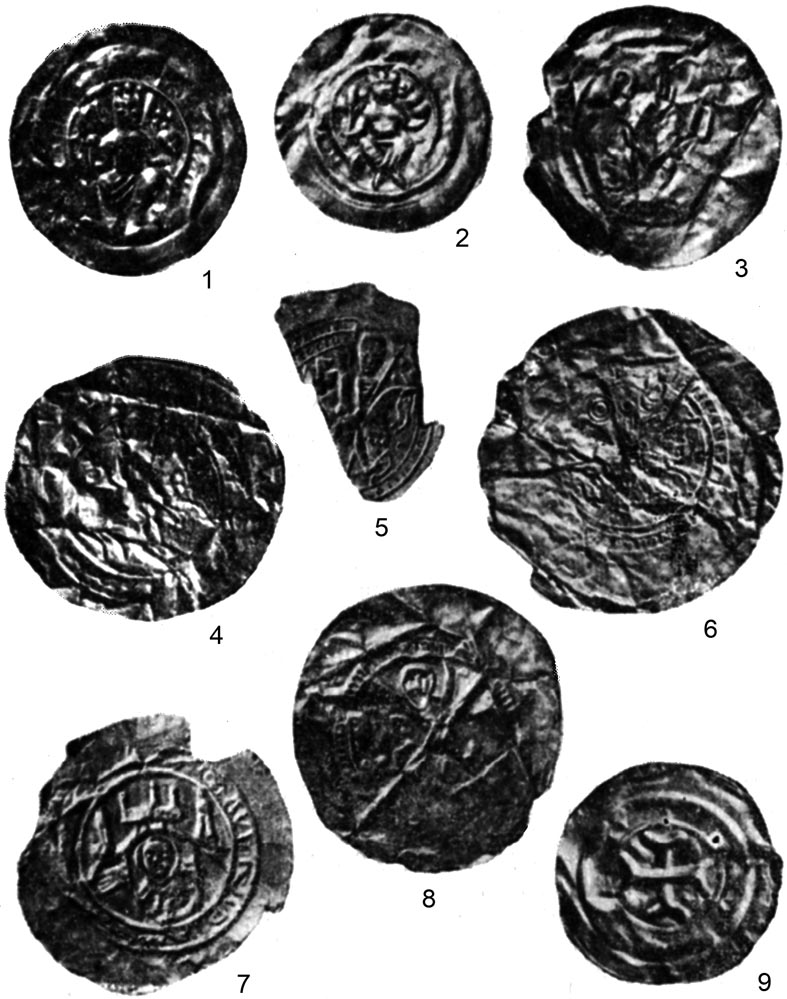
Монети Хотинського скарбу: 1, 2 — Альтенбург, імператор Фрідріх І (1152—1190) і його наступники (до 1210 р.); 3 — Ерфурт, Христіан І (1160—1161, 1165—1183); 4 — Мансфельд, Бурхард І (1184—1229); 5 — Тюрингія, Людвіг ІІІ (1172—1190); 6 — Тюрингія, Герман І (1190—1217); 7 — Галле, Альберт (1205—1232); 8 — Ешвеге, Гертруда (бл. 1180—1188); 9 — Пегау, Зігфрід (1185—1224) (Державний Ермітаж, за Потин 1963)
Coins of the Khotyn treasure: 1, 2 — Altenburg, Emperor Frederick I (1152—1190) and his successors (until 1210); 3 — Erfurt, Christian I (1160—1161, 1165—1183); 4 — Mansfeld, Burhard I (1184—1229); 5 — Thuringia, Ludwig III (1172—1190); 6 — Thuringia, German I (1190—1217); 7 — Halle, Albert (1205—1232); 8 — Eschwege, Gertrude (c. 1180—1188); 9 — Pegau, Siegfried (1185—1224) (State Hermitage, according to Potyn 1963)
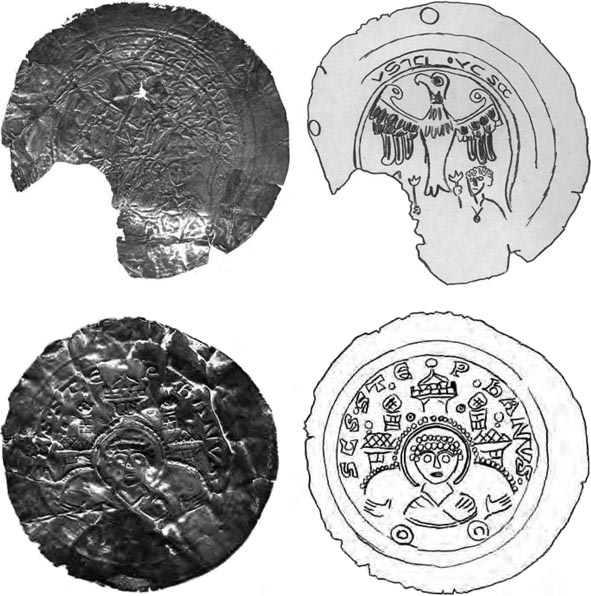
Брактеат Вальтера III (1176—1196), графа Арнштайна, монетний двір Хетштедт і Гардольфа фон Харбке (1193—1201) (?), єпископство Хальберштадт (Державний Ермітаж, за Чернышов 2021)
Bracteate of Walter III (1176—1196), Count Arnstein, Mint of Hetstedt and Hardolph von Harbke (1193—1201) (?), Bishopric of Halberstadt (State Hermitage, according to Chernyshov 2021)
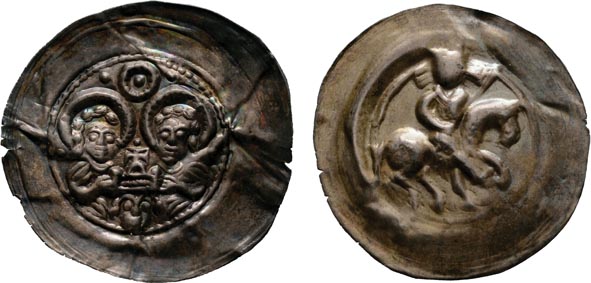
Брактеати Гослару (із зображенням поясних портретів святих Симона та Юди з німбами, які тримають корону, монетний двір Гослар (діаметр — 31—32 мм; вага — 0,79 г) й Оттона І, землі Вельфів, з 1235 р. герцогство Брауншвейг і Люнебург, монетний двір Геттінген (діаметр — 30,5—31 мм; вага — 0,765 г; Нижньосаксонський крайовий музей у Ганновері)
Bracteates of Goslar (depicting a half-length portrait of Saints Simon and Jude with halos holding crowns, Goslar Mint (diameter — 31—32 mm; weight — 0.79 g)) and Otto I, Land of the Welf, from 1235 Duchy of Braunschweig and Lüneburg, Göttingen mint (diameter — 30.5—31 mm; weight — 0.765 g; Lower Saxon State Museum Hanover)
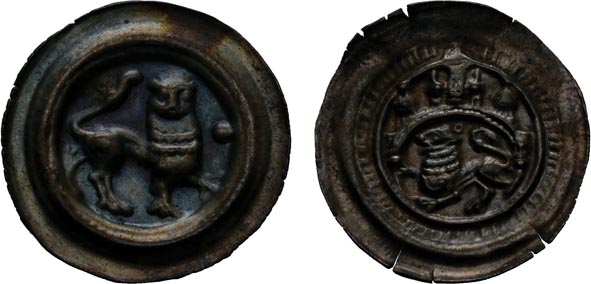
Брактеати Генріха ІІІ, землі Вельфів, герцогство Саксонія, монетний двір Люнебург (діаметр — 20,5—23,5 мм; вага — 0,535—0,54 г; Нижньосаксонський крайовий музей у Ганновері)
Bracteates of Henry III, Welf lands, Duchy of Saxony, Lüneburg mint (diameter — 20.5—23.5 mm; weight — 0.535—0.54 g; Lower Saxon State Museum in Hanover)
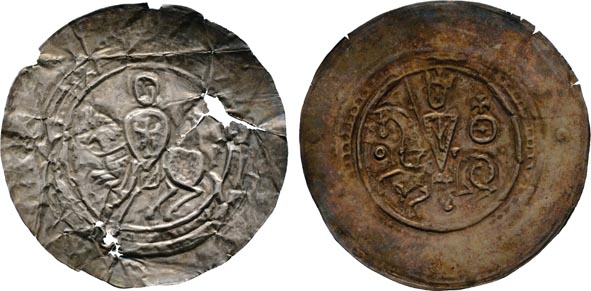
Брактеати Фрідріха II, Фогт фон Ольдеслебен (бл. 1189—1217), графство Бейхлінген, монетний двір Бад-Франкенхаузен (діаметр — 45 мм; вага — 0,89 г; Нижньосаксонський крайовий музей у Ганновері) й Оттона ІV, Мюльхаузен / Тюрінгія, Священна Римська імперія, монетний двір Мюльхаузен / Тюрінгія (діаметр — 45,5—46 мм; вага — 0,73 г; Нижньосаксонський крайовий музей у Ганновері)
Bracteates of Frederick II, Vogt von Oldesleben (ca. 1189—1217), Beichlingen County, Bad Frankenhausen Mint (diameter — 45 mm; weight — 0.89 g; Lower Saxon State Museum in Hanover) and Otto IV, Mühlhausen / Thuringia, Holy Roman Empire, Mühlhausen / Thuringia mint (diameter — 45.5—46 mm; weight — 0.73 g; Lower Saxon State Museum in Hanover)
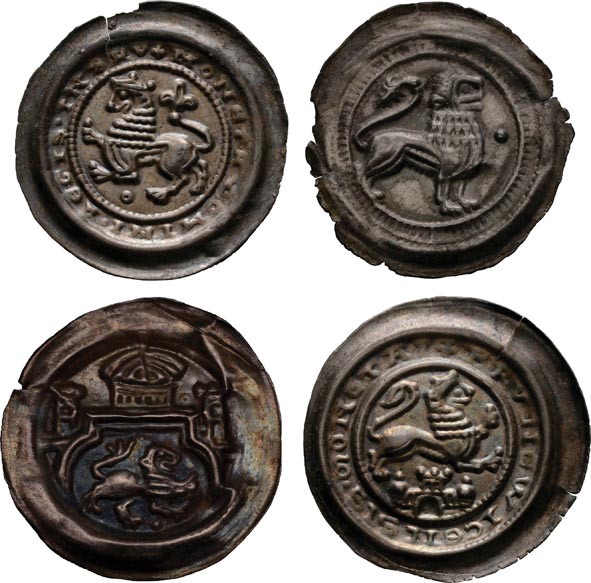
Брактеати Оттона ІV, землі Вельфів, Священна Римська імперія, монетний двір Вольфенбюттель, Брауншвейг (діаметр — 26—27 мм; вага — 0,765—0,81 г; Нижньосаксонський крайовий музей у Ганновері)
Bracteates of Otto IV, Welfs lands, Holy Roman Empire, Wolfenbüttel mint, Braunschweig (diameter — 26—27 mm; weight — 0.765—0.81 g; Lower Saxon State Museum in Hanover)
22.12.2022
Проєкт здійснено за підтримки Стабілізаційного фонду культури й освіти Федерального міністерства закордонних справ Німеччини та Goethe-Institut. goethe.de
The project is funded by the Stabilisation Fund for Culture and Education of the German Federal Foreign Office and the Goethe-Institut. goethe.de








